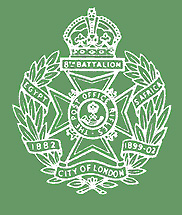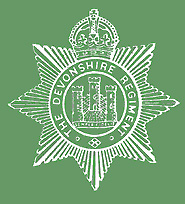Here you will be able to learn more about the regiments who built the original badges. Click on the links below to find out more about the particular badge…
Royal Wiltshire Yeomanry
(Prince of Wales’ Own Regiment)
 On 5th March 1794 Mr Pitt proposed in the House of Commons various measures for strengthening the internal defences of the country, as a result of which a meeting was held at the Bear Inn, Devizes and ten troops of Yeomanry Cavalry were raised in Wiltshire, eventually being formed into “The Regiment of Wiltshire Cavalry Yeomanry” in 1797. The honour of “Royal” was bestowed in 1831. In 1863, in recognition of the distinguished honour of forming an escort to HRH The Prince of Wales, a new title of “Prince of Wales’ Own Royal Regiment” was received. In 1884 HM The Queen authorised a table of precedence for the several regiments of Yeomanry in Great Britain and the position allotted to the Royal Wiltshire Yeomanry was Number One.
On 5th March 1794 Mr Pitt proposed in the House of Commons various measures for strengthening the internal defences of the country, as a result of which a meeting was held at the Bear Inn, Devizes and ten troops of Yeomanry Cavalry were raised in Wiltshire, eventually being formed into “The Regiment of Wiltshire Cavalry Yeomanry” in 1797. The honour of “Royal” was bestowed in 1831. In 1863, in recognition of the distinguished honour of forming an escort to HRH The Prince of Wales, a new title of “Prince of Wales’ Own Royal Regiment” was received. In 1884 HM The Queen authorised a table of precedence for the several regiments of Yeomanry in Great Britain and the position allotted to the Royal Wiltshire Yeomanry was Number One.
As you look at the badge today, all that remains of the original is the Prince of Wales’ feathers. The belt containing the Regimental motto “primus in Armis” and the scroll with the Regimental title together with the crown and lion have long since disappeared.
6th Battalion, The City of London Regiment
(City of London Rifles)
 Formed as the 2nd London Rifle Volunteer Corps in 1860, its members were recruited mostly from employees of the newspaper and printing industry, two whole companies being provided by the Daily Mail. The corps became a volunteer battalion of the King’s Royal Rifle Corps in 1881 and in 1900 sent a large contingent with the City Imperial Volunteers to South Africa. The title, 6th (City of London) Battalion, the London Regiment (Rifles) was assumed in 1908.
Formed as the 2nd London Rifle Volunteer Corps in 1860, its members were recruited mostly from employees of the newspaper and printing industry, two whole companies being provided by the Daily Mail. The corps became a volunteer battalion of the King’s Royal Rifle Corps in 1881 and in 1900 sent a large contingent with the City Imperial Volunteers to South Africa. The title, 6th (City of London) Battalion, the London Regiment (Rifles) was assumed in 1908.
During the First World War, both the 1/6th and 2/6th Battalions served in France and Belgium, while the 3/6th became the 6th (Reserve) Battalion in 1916. Also in 1916 the ‘Rifles’ became part of the KRRC. In 1935 they transferred to the Royal Engineers as 31 Anti Aircraft Battalion.
Australian Imperial Force Badge
(The Rising Sun)
 In 1885 Major (later Major General) Joseph Maria Gordon, the first commander at Fort Glanville, designed a trophy to symbolise the military skill of defence. It consisted of a series of bayonets radiating out in a semi-circle from a crown.
In 1885 Major (later Major General) Joseph Maria Gordon, the first commander at Fort Glanville, designed a trophy to symbolise the military skill of defence. It consisted of a series of bayonets radiating out in a semi-circle from a crown.
Commander (later Vice Admiral) William Rooke Creswell, commandant of the naval forces of South Australia and Commanding Officer of Her Majesty’s Colonial ship “Protector” then undertook to have the trophy made.
Major General Sir Edward Hutton, the newly appointed first Commander-in-Chief of the Australian Forces used this trophy as his inspiration when he requested a General Service Badge to be worn by the Australian soldiers in South Africa. So it was that in 1902 the first rising sun badges were worn with pride by the troopers of 1st Battalion Australian Commonwealth Horse, which was raised after Federation.
Proudly worn in two world wars, the rising sun, officially known as the General Service Badge of the Imperial Forces, became one of the best recognised and honoured insignia of the allied armies. An integral part of the digger tradition, its distinctive shape, worn on the upturned brim of a slouch hat is readily identified with the spirit of ANZAC.
The Fovant Badges Society acknowledges with gratitude the support of the Australian Department of Veterans’ Affairs (DVA). DVA, via its Overseas Privately Constructed Memorial Restoration Program, provides an annual grant for the preservation of the Australian Imperial Forces badge (now known as the Australian Commonwealth Military Force badge).
Royal Corps of Signals
 The first regular signals unit of the British army was formed in 1870 – C Telegraph Group of the Royal Engineers. This unit became The Royal Engineers Signals Service in 1912. In June 1920 The Corps of Signals was formed. This became The Royal Corps of Signals six weeks later in August 1920. The Corps takes precedence next after the Royal Engineers. The Badge on Fovant Down was cut in 1970 to commemorate the 50th anniversary of the Corps’ formation.
The first regular signals unit of the British army was formed in 1870 – C Telegraph Group of the Royal Engineers. This unit became The Royal Engineers Signals Service in 1912. In June 1920 The Corps of Signals was formed. This became The Royal Corps of Signals six weeks later in August 1920. The Corps takes precedence next after the Royal Engineers. The Badge on Fovant Down was cut in 1970 to commemorate the 50th anniversary of the Corps’ formation.
The Wiltshire Regiment
(Duke of Edinburgh’s)
 The Regiment consists of two former Regiments of Foot, the 62nd and the 99th, which were linked together under the Cardwell system in 1881 as the Wiltshire Regiment, the 62nd becoming the 1st Battalion and the 99th the 2nd Battalion. The two Battalions were amalgamated in Germany in 1948 and in 1953 HM The Queen graciously gave permission for Philip, Duke of Edinburgh, to become Colonel-in-Chief of the Regiment, as the 1st Duke of Edinburgh had been for the 99th Regiment of Foot.
The Regiment consists of two former Regiments of Foot, the 62nd and the 99th, which were linked together under the Cardwell system in 1881 as the Wiltshire Regiment, the 62nd becoming the 1st Battalion and the 99th the 2nd Battalion. The two Battalions were amalgamated in Germany in 1948 and in 1953 HM The Queen graciously gave permission for Philip, Duke of Edinburgh, to become Colonel-in-Chief of the Regiment, as the 1st Duke of Edinburgh had been for the 99th Regiment of Foot.
The Home Guard
(Wiltshire Regiment)
Early in 1950 members of the Association, Fovant Home Guard Old Comrades, decided to cut out the badge of the Wiltshire Regiment – the cap badge that they had worn during the war as members of the Home Guard – and with the permission of the Colonel of the Regiment, this very fine badge joined the others.
London Rifle Brigade
 The London Rifle Brigade, popularly known as the LRB, was formed as the 1st London Rifle Volunteer Corps in 1859 and within a short time consisted of fifteen companies. In 1908 the 1st Londons became the 5th (City of London) Battalion, The London Regiment (London Rifle Brigade) and as such served throughout France and Belgium during the First World War. One member of the battalion gained the Victoria Cross south of Wieltje, St Julien Road on 13 May 1915.
The London Rifle Brigade, popularly known as the LRB, was formed as the 1st London Rifle Volunteer Corps in 1859 and within a short time consisted of fifteen companies. In 1908 the 1st Londons became the 5th (City of London) Battalion, The London Regiment (London Rifle Brigade) and as such served throughout France and Belgium during the First World War. One member of the battalion gained the Victoria Cross south of Wieltje, St Julien Road on 13 May 1915.
In 1937 the battalion left the London Regiment and was designated as The London Rifle Brigade, The Rifle Brigade (Prince Consort’s Own). The battalion was divided as 1st and 2nd LRB in 1939. The 1st became a motorised unit and in 1941 was redesignated as the 7th Battalion, Rifle Brigade. After serving in Egypt, Libya and N Africa, the 7th became a lorried infantry battalion while serving in Italy during 1944.
Formed in 1939, the 2nd LRB later became the 8th Battalion, Rifle Brigade and served in NW Europe throughout 1944-5.
The title, London Rifle Brigade, The Rifle Brigade was once again assumed in 1947, when the 7th and 8th Battalions were merged. In 1950 a new title, ‘London Rifle Brigade/Rangers’, was adopted upon amalgamation that year with the Rangers. This battalion is now represented by part of the 4th (Volunteer) Battalion, Royal Green Jackets.
The Post Office Rifles
(8th London Regiment)
 The formation of a rifle corps at the General Post Office in London was sanctioned by the War Office in February 1868. Designated as the 49th Middlesex Rifle Volunteer Corps, the 49th consisted of seven companies and was recruited from the minor staff of the Post Office. At this time, senior members were already serving as part of the 21st (Civil Service) Corps.
The formation of a rifle corps at the General Post Office in London was sanctioned by the War Office in February 1868. Designated as the 49th Middlesex Rifle Volunteer Corps, the 49th consisted of seven companies and was recruited from the minor staff of the Post Office. At this time, senior members were already serving as part of the 21st (Civil Service) Corps.
The 49th became the 24th in 1880 and the following year joined the Rifle Brigade as one of its volunteer battalions. In 1882 a scheme was approved for the formation from within the 24th of an Army Postal Service. The idea of the new unit was for it to undertake all postal duties connected with an army on active service overseas.
The Army Post Office Corps was formed and in 1882 joined the Expeditionary Force in Egypt. The 24th were subsequently awarded the battle honour ‘Egypt 1882’, making the Post Office Rifles the only territorial battalion to be thus honoured.
Members of the battalion also served in South Africa during the Boer War. In 1908 the 24th became the 8th (City of London) Battalion, the London Regiment, and as such fought throughout France and Belgium during the First World War. In 1916 the 24th became part of the Corps of the Rifle Brigade and in 1922 was amalgamated with the 7th London Regiment.
The Devonshire Regiment
 The Badge consists of an eight pointed star in silver, the centre enscrolled “The Devonshire Regiment”. Within the scroll is the Castle of Exeter (Rougemont Castle) in silver on a blue ground with the Regimental Motto, “Semper Fidelis”, underneath. In place of the top point of the star is the Queen’s Crown in gold.
The Badge consists of an eight pointed star in silver, the centre enscrolled “The Devonshire Regiment”. Within the scroll is the Castle of Exeter (Rougemont Castle) in silver on a blue ground with the Regimental Motto, “Semper Fidelis”, underneath. In place of the top point of the star is the Queen’s Crown in gold.
The Regiment was raised in 1685 by Henry, Duke of Beaufort, to quell the rebellion caused by the landing of Henry, Duke of Monmouth, in Dorset, and was known as “The Duke of Beaufort’s Musketeers”.








